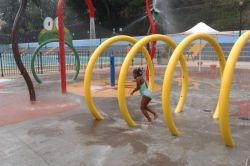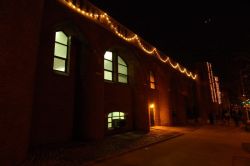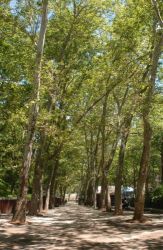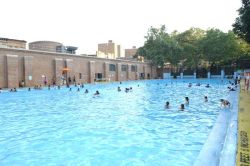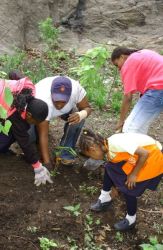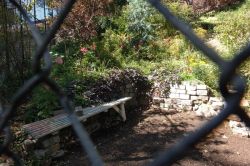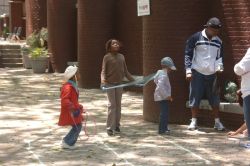Jackie Robinson Park
Jackie Robinson Pool
For outdoor pool details, including hours and rules, please visit our Free Outdoor Pools page.
What was here before?
Before the pool and play center were introduced to the park, the rugged terrain of glacial rock outcroppings and mature shade trees served the Harlem Heights community as a place of respite and passive recreation.
How did this site become a pool?
The summer of 1936, deep in the Great Depression, broke local heat records. Jackie Robinson Pool and Play Center was one of eleven immense outdoor public pools the Parks Department opened that summer. The heroically-scaled pools project was financed by the Federal Works Progress Administration (WPA), as part of a massive effort to alleviate adverse health conditions and provide safe recreation in predominantly working-class communities.
The pools were not just huge but also examples of state-of-the-art engineering and fine design. Each pool had separate swimming, diving and wading areas, perimeter bleachers, and bathhouses whose locker rooms served as gyms during non-summer months. Led by architect Aymar Embury II and landscape architect Gilmore D. Clarke, the planning team produced a series of distinct complexes, each one sensitive to its site and topography. Massive filtration systems, heating units, and even underwater lighting provided a more controlled bathing experience than the often treacherous and polluted waterways in which the City’s masses had traditionally swum. The palette of pools building materials was mainly inexpensive brick, concrete and cast stone, but the styles ranged from Romanesque Revival to Art Deco.
Harlem’s Jackie Robinson Pool measures 235 by 82 feet was designed by architects Aymar Embury II and Harry Ahrens to accommodate 4,090 bathers at a time. Nestled in a steep bluff, with an arcaded façade and entryway resembling a medieval castle, the facility was once known as “Colonial Park Pool,” in reference to the area’s role in key Revolutionary War battles. The facility opening on August 8, 1936 was cause for celebration and featured Bill “Bojangles” Robinson singing “Battle Hymm of the Republic” to a crowd of 25,000. The facility was named for baseball legend Jackie Robinson in 1978, and a bronze bust of Robinson by artist Inge Hardeson was installed in the lobby in 1981. The pool and play center (including the atrium interior) were designated an official New York City Landmark in 2007.
Who is this pool named for?
Jackie Robinson (1919-1972) is best known for his pioneering role as the first black professional baseball player in the major leagues. Born in Cairo, Georgia, on January 31, 1919 and raised in Pasadena, California, he attended UCLA where he excelled in baseball, basketball, football, and track. After World War II, Robinson played baseball in the Negro Leagues for the Kansas City Monarchs. Robinson made history on April 15, 1947, when he joined the Brooklyn Dodgers whom he would lead to six World Series appearances. Robinson retired from baseball in January 1957 and was inducted into the National Baseball Hall of Fame in 1962. He later became involved with the Chock Full O’ Nuts restaurant chain as well as several black-owned community enterprises. He was active in the National Association for the Advancement of Colored People (NAACP), and served as a special assistant to Governor Nelson A. Rockefeller. He died on October 24, 1972.
Check out your park's Vital Signs
Clean & Safe
Green & Resilient
Empowered & Engaged Users
Share your feedback or learn more about how this park is part of a
Vital Park System




